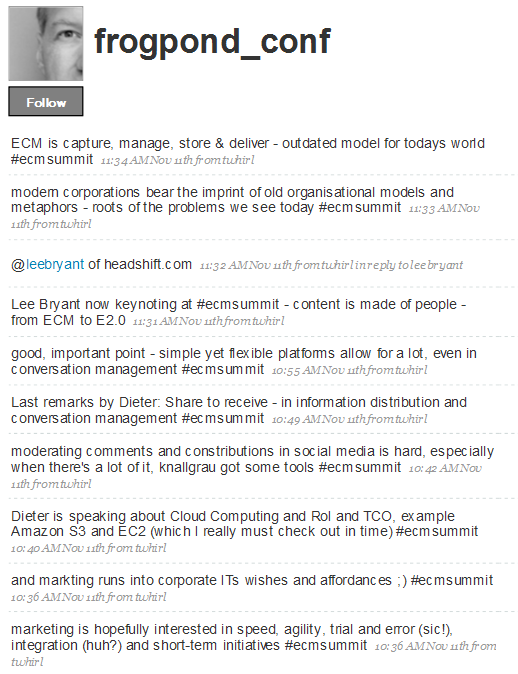Besides playing experimenting with some new (sometimes cloudy) collaboration services and technologies (and I didn’t even make it halfway here), battling a nasty cold and family time I’ve been reading my share of Enterprise 2.0 outlooks for 2009 lately, starting off with Gil Yehuda of Forrester (“Predicting the battle over collaboration infrastructure in 2009“) who answers short questions with good long analysis.
Gil, do you think companies will cut back on Enterprise Web 2.0 in light of the economy?
First reaction – it depends. I’m an analyst, that’s always our first answer. […]
That’s not all for sure, he goes on to ponder what lies behind all this, i.e. he delves into the relation between IT department and business units, diagnoses an increased need for collaboration functionality as a result of “layoffs, mergers, and deepening external partnerships (requiring new infrastructure to collaborate outside the firewall with trusted, external partners)”, and sees a slowdown of IT-driven collaboration projects in 2009 compensated by more business-driven collaboration projects. A good read.
More general are FastCompany’s predictions that 8 experts have for Web 2.0 in 2009, even with Charlene Li among them who holds
“[that] the biggest innovation will be the opening of social networks so that they can exchange profiles, social relationships, and applications. As such, companies need to think about how they will “open” up their businesses.”
Read-write web compiles a list of enterprise-focused web products that are already doing well and are poised success in 2009, nice that there’s a subcategory of Wiki++ (oh, this geeky humour):
We added “++” to “wiki” because the leading vendors are rapidly incorporating micro-blogging, social networking, forums, and other collaboration tools. Integration is key, so we see this market moving towards suites, but with wiki at the core.
Yes, said that before, think “middleware for humans” – one might even argue that wikis are archetypical infrastructure, and being flexible enough to cater for diverse and changing needs.
Then Craig Roth of the Burton Group presents their views of the 2009 landscape for communication, collaboration and content and warns
It’s also important to note the cyclical nature of organizational dynamics, which underlies everything we talk about related to communication, collaboration, and content. Rather than just disappearing, terms like “knowledge management” fade from view only to be rediscovered when their time is right. Governance has been on the tip of the tongue for at least five years now in our space, but it may fade only to be rediscovered under a new name ten years from now.
That is why it is so important to understand the basic concepts and dynamics behind communication, collaboration, and content before delving into the specifics of any specific technology. If you don’t understand your history, for example, social networking can be felled by the same issues that caused collaborative workspaces to fail before them.
Craig also blogged about the implications of the tough economic conditions on the collaboration (and IT) market, something on which I will post a follow-up soon as well. Actually I think that the economic crisis might even turn out good for collaboration initiatives, open source and Enterprise 2.0 …:
Companies that come out of recessions in a stronger position than they went in are those that judiciously invest in technology and related processes that let more work get done with less resources as well as reducing costly delays and red herrings when making decisions. And when the market downturn ends – and it will – opportunistic organizations will be in a better position to succeed than those that had hunkered down during the recession.
Some more quotes and notables:
– Mike Gotta thinks about some acquisition possibilities (or dangers) in the Enterprise 2.0 market, triggered by an article in CIO magazine “Web 2.0, Social Networks in ’09: The Year of Consolidation, Not Innovation” that puts Lotus Connections and Sharepoint in perspective (btw, I don’t buy the article’s argument that consolidation in the enterprise Web 2.0 market could hamper innovation around those tools, I guess the innovators in this space have set high standards already, plus the real issues aren’t with nifty tools et al.). Yet, the triggered reasoning by Mike on “strategic fits” is good, and I can’t help wondering if some of these M&As might turn reality in 2009. Besides he’s done a great rundown of various Enterprise 2.0 issues too …
– Robert Scoble sees a fight coming between the collaborative web and Microsoft, besides being busy talking to Socialtext and Jive Software (during his Enterprise disruption week), while David Coleman examines the underlying thinking (in “The Evolution of Collaboration Technologies“): “Most of these organizations are betwixt and between. It is safer to go with what you know (IBM or Microsoft) but also can be expensive in a recessionary period. Or phase out the aging collaborative infrastructure for something a bit more up to date, with more collaborative functionality. So far most of them seem to be playing it safe, a few are looking for new tools that will meet their collaborative needs both today (with the Millenials) and tomorrow.” and Kevin Mullins offers some Technology Predictions for 2009 (“I see Web 2.0 and Enterprise 2.0 becoming feature sets in new products and services in the Enterprise, however they will not become feature sets in all Enterprise products”). Well, fair chance and clever arguing 😉
– At last, CBC had a feature interview with Clay Shirky on the pros and cons of social media, new online business models online, and how big change comes from human motivation, not shiny new technologies. Well, yes, don’t blame the web intranet when it’s filter failure, yes, the ability to pay attention in the Web 2.0 age is the “work smarter, not harder” version 2.0
So now I wish all my readers, friends, colleagues, partners and clients a happy and successful 2009. I hope you all had time and rest to enjoy some quiet days with friends and family before the rat race starts again. Oh, again it’s making-fun-of-rats-time – I really must look out lest this turns out a standard operating procedure …?



